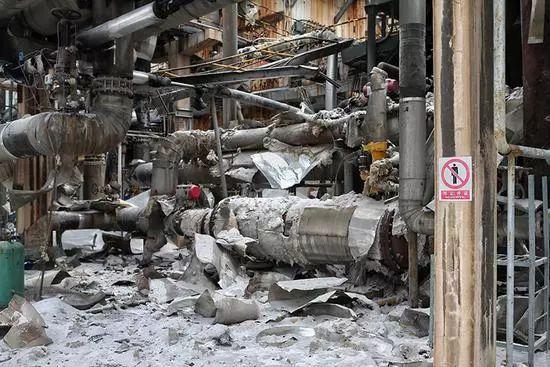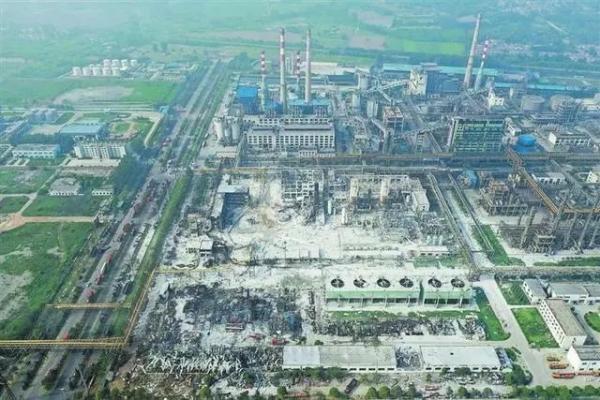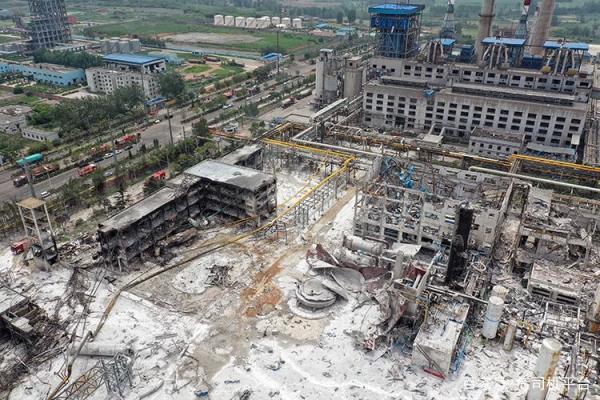The chemical plant exploded again!
Only 4 months have passed since the 321 Yancheng Xiangshui Chemical Enterprise explosion, and the chemical plant explosion has once again made headlines!
At 17:42 on July 19, an explosion occurred in the air separation workshop of the Yima Gasification Plant of Henan Energy and Chemical Industry Group in Sanmenxia City, Henan Province!
As of 17:00 on the 20th, the accident caused 15 deaths, 3 people missing, and 15 people seriously injured!

Every accident is so tragic, and learning lessons is the duty of every firefighter.
Determination of fire level
First, the fire accident levels are divided into four categories: general fire, major fire, serious fire and particularly serious fire. The judgment conditions are as follows:
General fire: refers to a fire that causes the death of less than 3 people, or serious injuries to less than 10 people, or direct property losses of less than 10 million yuan.
Major fire refers to a fire that causes the death of more than 3 but less than 10 people, or serious injuries to more than 10 but less than 50 people, or direct property loss of more than RMB 10 million but less than RMB 50 million.
Major fire: refers to a fire that causes the death of more than 10 but less than 30 people, or serious injuries to more than 50 but less than 100 people, or direct property loss of more than RMB 50 million but less than RMB 100 million.
Particularly serious fire: refers to a fire that causes the death of more than 30 people, or serious injuries to more than 100 people, or direct property losses of more than 100 million yuan.
The explosion in Sanmenxia City has killed 15 people and seriously injured 15 people. Although there may be new casualties in the future, it can basically be determined as a major fire.
Fire hazard level, fire resistance and explosion protection of factory buildings
The explosion occurred in the air separation workshop. The air separation plant is Class B and has explosion hazards.
It can be seen from the "Building Fire Protection Design Code" that Class B factory buildings with explosion hazards should be set up independently and should adopt open or semi-open types, and pressure relief facilities should be installed in areas with explosion hazards.
The fire resistance level of the air separation plant should not be lower than level 2. If it is an independent single-storey plant with a construction area of no more than 300m2, level 3 fire resistance can be adopted.
The above is just very basic fire protection knowledge

On July 2, Yima Gasification Plant hosted the 2019 Yima City Simulation Emergency Rescue Drill for the Liquid Ammonia Tank Area Leakage Accident of Yima Gasification Plant. Yima City's safety, fire, public security, emergency rescue, environmental monitoring and other departments jointly carried out emergency rescue. The drill lasted 25 minutes and was a complete success.
According to the Yima Municipal Government, an explosion and fire occurred in the C-set air separation unit of the Yima Gasification Plant of Henan Gas (Group) Co., Ltd. The explosion did not involve the tank area of major hazardous sources, and all production units have been shut down. Two people have not been contacted, and no deaths have been found so far. The specific casualties are under investigation.
What caused the explosion?
Expert: Pressure vessel release may be out of control
A worker at the factory where the accident occurred said that there may be two reasons for the explosion. One is that the high pressure broke the equipment apart; the other is that the separated flammable gas came into contact with the sparks generated by the friction of the equipment.
Cao Jian, deputy chief engineer of Sinopec Engineering Construction Company, said that the air separation unit is relatively safe, with its characteristic of deep cold separation and operation at -150°C. The explosion may be caused by the uncontrolled release of the pressure vessel, resulting in overpressure.
The Publicity Department of the Sanmenxia Municipal Party Committee of Henan Province previously reported that the explosion did not involve any major hazardous source tank area, and all production equipment had been shut down. After the incident, the local government has activated the emergency plan, and the emergency management, public security, fire, health, and environmental protection departments have rushed to the scene of the accident.

On-site photos
According to official reports, as of press time on July 21, the accident had caused 15 deaths and 15 serious injuries. Reporters who went to the scene of the accident found that residential areas 3 kilometers away from the accident site were affected by the explosion, but no students in schools and kindergartens within 1 kilometer were injured because it was summer vacation.
The company involved conducted a simulated emergency rescue drill a few days before the explosion
Safety in production is not just a slogan:
Measures to prevent over-temperature, over-pressure and explosion
In summer, the long sunshine hours and high temperatures accelerate the decomposition, gasification, heating and expansion of flammable and explosive materials, which can easily cause equipment overheating and overpressure, and in severe cases, explosion accidents may occur. To prevent overheating and overpressure, the following matters need to be paid attention to.
(1) Safety facilities of boilers, pressure vessels and other equipment, such as safety valves, pressure gauges, breathing valves, pressure reducing valves, liquid level gauges, thermometers, quick shut-off valves, water curtains, sprinkler facilities, etc., must be kept in good condition and 100% in use.
(2) The storage capacity of atmospheric pressure storage tanks should be strictly controlled within the safety critical range, and overfilling is strictly prohibited. Non-open barrels and cans containing dangerous chemicals should not be filled to the brim, and a 10% to 15% gap should be left to prevent the flammable liquids contained from expanding due to heat and causing the container to explode.
(3) The pressure vessel should be operated smoothly. When loading, the speed should not be too fast to prevent a sudden increase in pressure. Heating or cooling should be done slowly to avoid large pressure fluctuations and accidents. All equipment and pipelines that are out of service should be properly depressurized and purged.
(4) For equipment that is prone to overheating and overpressure, such as compressors, nitrogen generators, and electrical equipment, measures such as rotating work or suspending operations should be implemented.
(5) The integrity of the venting and pressure relief systems should be monitored at all times to ensure that they are in good working order. Areas where leakage may occur should be monitored and inspected closely. High-altitude venting points and possible leakage points should be controlled closely to prevent leakage from catching fire due to lightning strikes.
(6) The indoor temperature and ventilation of the main control room, instrumentation room, electrical equipment operation room and other places should be controlled at normal conditions.
(7) Strengthen process management, adjust process indicators in a timely manner, strictly prohibit over-temperature, over-pressure, and overload production, and operators should be careful and conscientious in their work, pay close attention to the working conditions of heat exchange equipment, the operation of cooling water, and abnormal changes in temperature, liquid level, and pressure, and increase inspection efforts to prevent running, bubbling, dripping, and leakage.
I hope all chemical companies can pay attention to safety issues, strengthen employee safety production education, and take precautions before problems occur!
In order to better reduce such safety accidents, it is necessary to install monitoring sensors in chemical plants to monitor gas leaks in real time. Shenzhen Gongcai.com provides catalytic combustion methane sensors (CH4 sensors) CH-A3 and CH-D3, which can be used to detect combustible gas leaks in chemical plants to avoid tragedies from happening again.
Previous article:GUVS-T10EC high temperature UV sensor is used in high temperature curing box for detection
Next article:Relocating to Germany, keeping the name, ams proposes marriage to OSRAM
- Popular Resources
- Popular amplifiers
- Melexis launches ultra-low power automotive contactless micro-power switch chip
- Infineon's PASCO2V15 XENSIV PAS CO2 5V Sensor Now Available at Mouser for Accurate CO2 Level Measurement
- Milestone! SmartSens CMOS image sensor chip shipments exceed 100 million units in a single month!
- Taishi Micro released the ultra-high integration automotive touch chip TCAE10
- The first of its kind in the world: a high-spectral real-time imaging device with 100 channels and 1 million pixels independently developed by Chinese scientists
- Melexis Launches Breakthrough Arcminaxis™ Position Sensing Technology and Products for Robotic Joints
- ams and OSRAM held a roundtable forum at the China Development Center: Close to local customer needs, leading the new direction of the intelligent era
- Optimizing Vision System Power Consumption Using Wake-on-Motion
- Infineon Technologies Expands Leading REAL3™ Time-of-Flight Portfolio with New Automotive-Qualified Laser Driver IC
- LED chemical incompatibility test to see which chemicals LEDs can be used with
- Application of ARM9 hardware coprocessor on WinCE embedded motherboard
- What are the key points for selecting rotor flowmeter?
- LM317 high power charger circuit
- A brief analysis of Embest's application and development of embedded medical devices
- Single-phase RC protection circuit
- stm32 PVD programmable voltage monitor
- Introduction and measurement of edge trigger and level trigger of 51 single chip microcomputer
- Improved design of Linux system software shell protection technology
- What to do if the ABB robot protection device stops
- How Lucid is overtaking Tesla with smaller motors
- Wi-Fi 8 specification is on the way: 2.4/5/6GHz triple-band operation
- Wi-Fi 8 specification is on the way: 2.4/5/6GHz triple-band operation
- Vietnam's chip packaging and testing business is growing, and supply-side fragmentation is splitting the market
- Vietnam's chip packaging and testing business is growing, and supply-side fragmentation is splitting the market
- Three steps to govern hybrid multicloud environments
- Three steps to govern hybrid multicloud environments
- Microchip Accelerates Real-Time Edge AI Deployment with NVIDIA Holoscan Platform
- Microchip Accelerates Real-Time Edge AI Deployment with NVIDIA Holoscan Platform
- Melexis launches ultra-low power automotive contactless micro-power switch chip
- BOOST Circuit
- 【Portable Environmental Status Detector】Work Submission
- Are there any electromagnetic radiation issues with LED luminous characters?
- Development Background and Characteristics of 5G Industrial Gateway in the Internet of Things
- MSP430 FRAM Technology – How-tos and Best Practices
- ESP32-CAM Video Surveillance Robot
- Ask the Experts | Confused about DC-DC selection? MPS can help you solve it!
- A comprehensive analysis of dipole antennas
- MicroPython Hands-on (29) - SIoT of the Internet of Things
- 【Smart water cup holder】06-Work submission

 LT1014DN#PBF
LT1014DN#PBF











 京公网安备 11010802033920号
京公网安备 11010802033920号